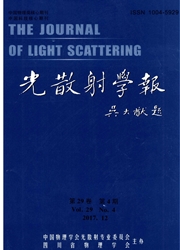

 中文摘要:
中文摘要:
中国是丝绸之路的发源地,染色历史源远流长。文物及艺术品中的有机染料蕴含着制作年代、原料来源、染色工艺及保存状况等丰富的信息,但因染料成分复杂、含量低、易于降解,其鉴定一直是文物分析领域的难点。拉曼光谱作为一种指纹光谱在文物及艺术品中染料分析方面具有独特的优势。系统阐述了显微拉曼光谱法(MRS/μ-Raman)、近红外傅里叶变换拉曼光谱法(NIR-FT-Raman)、表面增强拉曼光谱法(SERS)、共振拉曼光谱(RRS)法的原理、特点、局限性以及在染料鉴定中的研究进展和发展方向;分类归纳总结出了黄栀子、姜黄等染料的拉曼光谱特性;对比分析了紫茜素在采用不同波长激光器激发下的荧光现象;介绍了以自制的灰绿色银胶颗粒为基底,联合薄层色谱(TLC)分离技术及SERS鉴定茜草中的色素,表明银溶胶微粒产生的表面增强效应可显著降低拉曼光谱荧光背底。指出拉曼光谱作为一种快速、便捷的结构定性测试手段在文物和艺术品染料分析中应用前景广阔,提出多种拉曼光谱技术相结合、拉曼光谱技术与分离技术相结合以及拉曼光谱技术与远距离传导技术相结合是拉曼光谱技术的发展趋势。
 英文摘要:
英文摘要:
As the birthplace of Silk Road,China has a long dyeing history.The valuable information about the production time,the source of dyeing material,dyeing process and preservation status were existed in organic dyestuff deriving from cultural relics and artifacts.However,because of the low contents,complex compositions and easily degraded of dyestuff,it is always a challenging task to identify the dyestuff in relics analyzing field.As a finger-print spectrum,Raman spectroscopy owns unique superiorities in dyestuff identification.Thus,the principle,characteristic,limitation,progress and development direction of microRaman spectroscopy(MRS/μ-Raman),near infrared reflection and Fourier transform Raman spectroscopy(NIR-FT-Raman),surface-enhanced Raman spectroscopy(SERS)and resonance raman spectroscopy(RRS)have been introduced in this paper.Furthermore,the features of Raman spectra of gardenia,curcumin and other natural dyestuffs were classified by MRS technology,and then the fluorescence phenomena of purpurin excitated with different wavelength laser was compared and analyzed.At last,gray green silver colloidal particles were made as the base,then the colorant of madder was identified combining with thin layer chromatography(TLC)separation technology and SERS,the result showed that the surface enhancement effect of silver colloidal particles could significantly reduce fluorescence background of the Raman spectra.It is pointed out that Raman spectroscopy is a rapid and convenient molecular structure qualitative methodology,which has broad application prospect in dyestuff analysis of cultural relics and artifacts.We propose that the combination of multi-Raman spectroscopy,separation technology and long distance transmission technology are the development trends of Raman spectroscopy.
 同期刊论文项目
同期刊论文项目
 同项目期刊论文
同项目期刊论文
 Application and Progress of the Nondestructive Spectral Technology Used in Polychrome Ceramic Relics
Application and Progress of the Nondestructive Spectral Technology Used in Polychrome Ceramic Relics Analysis of the techniques and materials of the coloured paintings in the Renshou Hall in the Summer
Analysis of the techniques and materials of the coloured paintings in the Renshou Hall in the Summer 期刊信息
期刊信息
